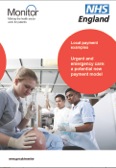News / Emergency care payment proposals cover volume, performance and fixed costs
 Monitor and NHS England published detailed guidance on how to develop and implement a local payment mechanism to support urgent and emergency care (UEC) reform in August. NHS England also announced UEC vanguards to transform care.
Monitor and NHS England published detailed guidance on how to develop and implement a local payment mechanism to support urgent and emergency care (UEC) reform in August. NHS England also announced UEC vanguards to transform care.
The document examines a three-part payment approach for all organisations involved in the delivery of urgent and emergency care, including NHS 111, GP out-of-hours services, ambulance, A&E and emergency admissions to hospital.
Urgent and emergency care – a potential new payment model said the fixed core payment would make up a substantial proportion of the reimbursement to reflect the ‘always-on’ nature of UEC services. It would focus commissioner and provider attention on planning capacity to meet agreed access and quality standards and reflect how capacity is expected to change as the new care model and patient flows take effect.
The level of core payment would depend on the service. An example given in the document gives core payment percentages at 80% for NHS 111 and ambulance services, 70% for A&E and 60% for emergency admissions. The volume-based element would let providers meet demand where it differed from expected demand and enable the sharing of financial risk. It would ensure part of the payment reflected casemix and volume of need met. The third element would relate to outcome and performance to encourage co-ordination, improve patient flow and promote quality improvements.
According to the document, the proposed approach was best applied to all providers and services in a local network.
NHS England chief executive Simon Stevens announced eight urgent care vanguards covering more than nine million people. Six vanguards
cover smaller local systems, which may include hospitals and surrounding GP practices and social care, while two network vanguards work with much larger populations to integrate care on a greater scale.
‘The NHS will begin joining up the often confusing array of A&E, GP out-of-hours, minor injuries clinics, ambulance services and 111, so that patients know where they can get urgent help easily and effectively, seven days a week,’ he said. ‘That’s why we’re backing our frontline nurses, doctors and other staff, in partnership with local communities, to radically redesign our urgent and emergency services.’
|
Local modification first Monitor said the modification reflected the higher costs of running services on multiple sites in rural locations. Local commissioners should pay more than the tariff price in six essential services provided by the trust: A&E; general surgery; trauma and orthopaedics; paediatrics; women’s health; and non-elective medical specialties. It is estimated the trust will receive an extra £20m-£25m, depending on activity, reducing its need for further funding from the Department of Health, Monitor said. Trust director of finance and deputy chief executive Aaron Cummins (pictured) said: ‘We welcome the announcement by Monitor about the modification to our tariff. We particularly welcome the recognition from Monitor that we face a unique challenge in this area – providing healthcare across five sites to a population size that often, in more urban areas, is served by fewer hospitals.’ The trust will have to apply each financial year to renew the modification. ‘Our longer term strategy seeks to address the structural issues, meaning the requirements for the local price modification will reduce over time,’ he added. |
Related content
The Institute’s annual costing conference provides the NHS with the latest developments and guidance in NHS costing.
The value masterclass shares examples of organisations and systems that have pursued a value-driven approach and the results they have achieved.